This delicious soup is a one-pot meal containing ingredients that are linked to reducing belly fat, including whole grains, fibre, healthy fats, peppers and flavonoid-rich fruits and vegetables. What’s more, it’s easy to make, taking only 25 minutes from stove-top to table.
Ingredients
- 2 cups (500 mL) Whole grain bows, such as Catelli® Healthy Harvest® brand
- 2 tsp (10 mL) extra virgin olive oil
- 1 small red onion, chopped
- 1 red pepper, chopped
- 1/4 cup (50 mL) dried cranberries
- 4 cloves garlic, minced
- 1 tbsp (15 mL) mild chili powder
- 1 tsp (5 mL) ground cumin
- 3/4 tsp (4 mL) each salt and pepper
- 8 cups (2 L) low sodium vegetable broth (approx.)
- 1 can (14 oz/398 mL) no salt added diced tomatoes
- 2 cans (14 oz/398 mL each) no salt added black beans, drained and rinsed
- 1 cup (250 mL) corn kernels, thawed
- 4 cups (1 L) lightly packed baby spinach
- 2 jalapeno peppers, seeded and chopped
- 1 lime, zested and juiced (approx.)
- Chopped fresh coriander (optional)
Instructions
- Heat the olive oil in a large pot or Dutch oven set over medium-high heat. Add the onion and red pepper; sauté for 2 to 3 minutes or until softened.
- Add the cranberries, garlic, chili powder, cumin, salt and pepper; cook, stirring, for 1 minute. Stir in 6 cups (1.5 L) broth and the tomatoes; bring to a boil.
- Stir in the beans, bows and corn. Boil gently, partially covered and stirring occasionally, for 12 minutes or until pasta is tender.
- Stir in the remaining broth, the spinach, jalapeno peppers, lime zest and juice; remove from the heat. (Add extra broth and lime juice to adjust consistency and acidity to taste if desired). Garnish with fresh coriander (if using). Makes 8 servings.
Notes
Tips: *Leftover soup is great to pack for lunches the next day. *For those who love spicy foods, increase the number of jalapeno peppers or stir in the seeds as well.
Per serving (about 1 1/3 cups/325 mL): 234 calories, 2 g fat, 0 g saturated fat, 0 mg cholesterol, 396 mg sodium, 43 g carbohydrates, 10 g fibre, 10 g sugars, 10 g protein. Excellent source of folate. Good source of vitamin C and iron
Recipe courtesy Catelli® Healthy Harvest® pasta. For more easy, belly fat-burning tips, visit www.wholegrainpasta.ca
This New Year, resolve to get the skinny on five fat-burning foods, including whole grains, soluble fibres and plant compounds
When resolving to lose weight this year, don’t rely on the scale. Measuring belly fat, rather than weight, is often a better indicator of a healthy body.
So says leading Canadian dietitian Liz Pearson, emphasizing that excess abdominal fat significantly increases the risk of health problems – such as heart disease, stroke, high blood pressure, type 2 diabetes and cancer – as well as death. It may also speed up the aging process and the onset of dementia.
“Even in people who don’t have a weight issue, abdominal fat can be a better predictor of disease risk than body mass index (BMI), particularly if the excess fat is located around the waist,” says Pearson, co-author of Ultimate Foods for Ultimate Health and author of Broccoli, Love and Dark Chocolate, to be released in 2013.
Pearson cites recent research from the Minnesota-based Mayo Clinic that found normal-weight people who have a central bulge are at almost three times greater risk of dying from heart disease, and two times greater risk of dying from any cause, than people of normal weight with no excess abdominal fat.
According to Health Canada, a red flag should be raised when women have a waist circumference of 88 centimetres (35 inches) or more and men have a circumference of at least 102 centimetres (40 inches). To measure circumference, wrap a soft tape measure around your waist just above the hip bone, relax your abdominal muscles and pull the ends of the tape measure snugly – but not tightly – together, Pearson advises.
With a new year in tow, now’s an ideal time to get the skinny on battling the bulge, says Pearson. For starters, eat these five fat-burning foods daily, she suggests.
100 percent whole grains
Research from Tufts University in Boston involving almost 3,000 men and women found that those who consumed three or more servings of whole grains each day had 10 percent less belly fat compared to those who consumed no whole grains. In another study conducted at Penn State in University Park, 50 obese adults ate a calorie-reduced diet for 12 weeks, with half the group making all their grain choices whole grains, and the other half eating refined grains. The whole grain eaters saw a significantly greater decrease in abdominal fat.
Canada’s Food Guide recommends that women get at least six servings of grains daily and men seven to eight servings. Each and every serving should be 100 percent whole grain, says Pearson, explaining that one serving is equivalent to half a cup of pasta, one slice of bread or one cup of cereal.
“Whole grains – such as 100 percent Catelli® Healthy Harvest® whole grain pasta, bread and cereal – offer many more vitamins, minerals, fibre and antioxidants than refined grains,” she explains, adding that studies confirm that even kids and teens who eat 100 percent whole grains are more likely to have a healthy body weight and less abdominal fat.
High Fibre
Researchers at Wake Forest Baptist Medical Center in North Carolina found a proven way to reduce belly fat is to eat more soluble fibre from vegetables, fruit and beans. The study found that for every 10-gram increase in soluble fibre eaten per day, abdominal fat was reduced by 3.7 percent over five years. Add moderate activity into the mix, and the result was a 7.4 percent decrease in the rate of belly fat accumulation over the same period.
Dietary fibres are found naturally in plants that we eat. They don’t break down in our stomachs, but rather, pass through our system undigested. Soluble fibre dissolves in water, while insoluble fibre doesn’t.
Pearson points to apples, citrus fruits, peas, beans, lentils, psyllium, oats, chia and flaxseeds as best bets when it comes to high-fibre soluble foods. Aim to consume five or more servings a day, with a serving equal to one medium-sized apple or orange, a half a cup of beans, peas or lentils, or one to two tablespoons of psyllium or flaxseed.
Healthy fats
A high intake of bad fats combined with a low intake of good fats is bad for your belly.
In research from University College Dublin School of Public Health in Ireland involving more than 1,700 men and women, diets high in unhealthy saturated fats and low in polyunsaturated fats, including omega-3 fats, were linked to a significantly higher risk of abdominal fat.
Excess belly fat negatively impacts how our bodies handle sugar and fats, and promotes chronic inflammation, yet good fats – including omega-3s, oils, nuts and seeds, peanut butter, avocados, olives and fatty fish – fight inflammation. Pearson suggests eating foods that contain healthy fats at least three times daily.
Limit unhealthy fats by consuming low fat milk products and lean meat. Read food labels and look for products that contain no more than two grams of saturated fat per serving and no trans fats.
Flavonoids
Flavonoids are potent antioxidants found in colourful fruits and vegetables, including berries, cherries, citrus fruits, plums, grapes, apples, red onions and dark leafy greens. They’re also present in red wine, tea and dark chocolate. They fight inflammation and preliminary research conducted mostly on animals shows they reduce belly fat too.
The best way to get plenty of flavonoids is to consume at least seven to 10 servings of brightly-coloured fruits and vegetables daily, Pearson explains.
“Make green tea your beverage of choice, and enjoy red wine and dark chocolate in small amounts,” she recommends. In addition to shrinking the belly over time, flavonoids help fight viruses and prevent infections.
Pepper-based plant compounds
Like flavonoids, early research shows that plant compounds from peppers help bust belly fat. Found in any pepper-derived food, including crushed red pepper flakes, hot peppers, jalapeño peppers, chili peppers and black pepper, these compounds should be used liberally in daily cooking and recipes, Pearson says.
Beyond food, exercise is key to keep abdominal fat in check, Pearson emphasizes. “It’s absolutely critical to commit to a regular routine of aerobic and resistance exercises,” she says, explaining that high intensity, intermittent exercises are the best when it comes to battling the bulge.
What’s more, “as you adopt a belly fat-fighting lifestyle, it’s just as important to be aware of factors that have the reverse effect on your waistline,” says Pearson, citing excess calorie intake, lack of physical activity, menopause, high intake of refined grains, excess sugar (including soft drinks), high alcohol volumes, smoking and stress as examples. The bottom line: “Be nice to your belly, it matters a lot.”
Visit www.lizpearson.com for more information and advice. For easy, belly fat-burning recipes the whole family will enjoy, visit www.wholegrainpasta.ca.
Latest posts by Canadian Home Trends (see all)
- Understanding The Importance of Great Design - January 7, 2026
- The Green Effect: To Clean or Not to Clean - January 7, 2026
- Functional Warm Addition - January 7, 2026

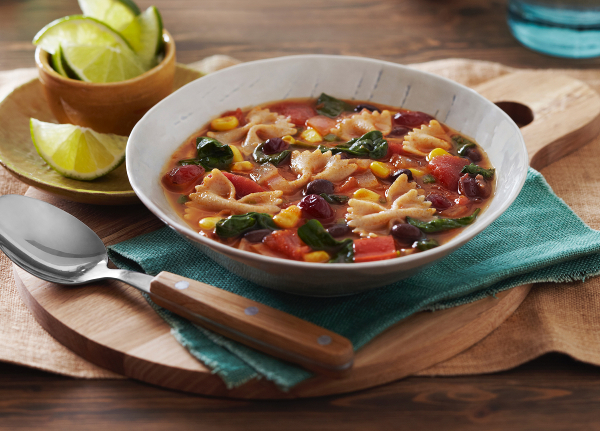

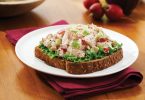
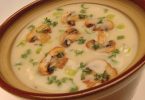
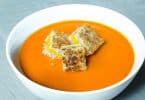
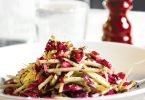
This soup looks delicious and really healthy